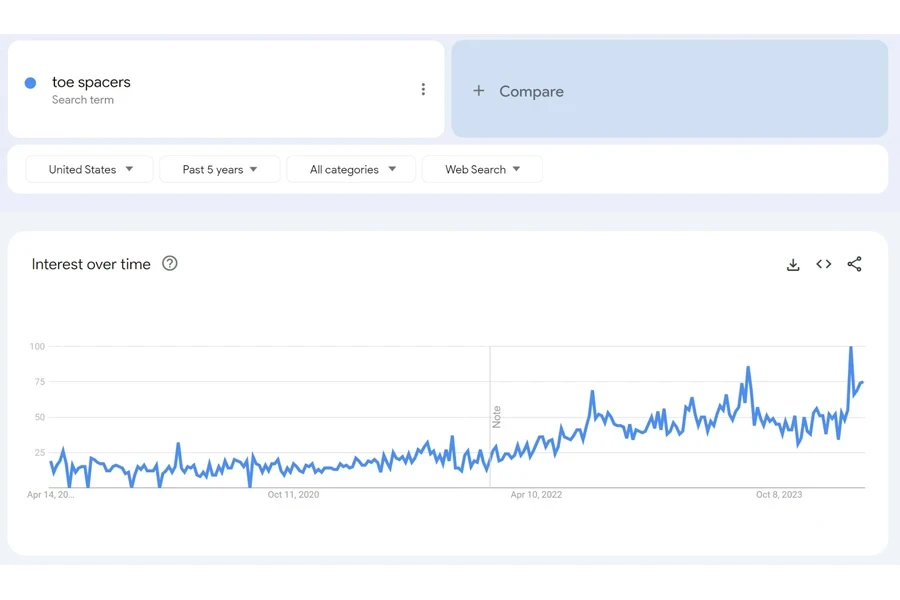In the fast-paced world of e-commerce, staying ahead means leveraging powerful tools like Google Trends. As consumer preferences and market trends evolve at breakneck speed, businesses need to be agile and proactive in their product research. This indispensable resource offers real-time insights into consumer interests, helping you align your product offerings with market demands. In this post, we’ll explore the hottest products to watch in 2024 and show you how to leverage Google Trends to stay ahead of the game.
Table of Contents
● 5 Trending products to sell in 2024 and beyond
● Google Trends 101: Crucial signals to watch
● Leveraging Google Trends for product research
5 Trending products to sell in 2024 and beyond
From magic mushrooms to eco-friendly sleepwear, here are the products that are poised to take the market by storm in 2024:
● The magic of mushroom coffee

Move over, matcha – there’s a new superfood in town. Mushroomcoffee has seen a surge in popularity since 2022. Health-conscious consumers are increasingly drawn to mushroom coffee as an alternative or addition to regular coffee due to its potential health benefits like immunity support and improved focus. To capitalize on this trend, consider offering ready-to-drink beverages or creating your own mushroom coffee blends. Different mushroom types in these products include lion’s mane, reishi, chaga, cordyceps, king trumpet, and turkey tail, each offering unique medicinal and adaptogenic traits worth exploring.
● Bamboo pajamas: The eco-friendly sleepwear sensation

Bamboo pajamas have been steadily rising in popularity in recent years, especially during the holiday seasons. Consumers are drawn to the eco-friendliness and comfort of bamboo fabric, making it a perfect choice for cozy nightwear, and a perfect choice for gifting season. This trend extends to various styles, including bamboo pajamas for kids, Halloween-themed versions, and matching sets for families, reflecting their growing market appeal. To tap into this trend, consider themed gift sets or collaborations with eco-conscious influencers.
● Toe spacers: The surprising foot care trend

Toe spacers, designed to alleviate foot pain and promote proper alignment, have seen a significant surge in popularity recently, making them an attractive addition to your offerings. Many potential customers are curious about the benefits and functionality of toe spacers. Seize this opportunity to engage and educate them through informative blogs, email newsletters, and social media content that addresses these common inquiries. Consider bundling toe spacers with other foot care products like massagers or moisturizing creams to create an irresistible self-care package.
● Laser hair removal: The evergreen beauty treatment

Over the last five years, “laser hair removal” has shown a stable and slightly increasing trend on Google Trends, indicating steady interest in the US. This suggests it could be a valuable and ideal long-term addition to your offerings. To diversify, consider exploring related products such as IPL (intense pulsed light) hair removal devices, facial hair removal tools, and comprehensive at-home hair removal kits that include aftercare items like moisturizers or exfoliators.
● Hair wax sticks: The TikTok-fueled phenomenon

Hair wax sticks offer a simple and mess-free method to maintain hairstyles with added texture and definition. Their cleanliness compared to other hairstyling products makes them highly appealing. Their popularity has surged in recent years, partly thanks to TikTok, where beauty influencers’ videos showcasing these products have attracted tens of millions of views.
Google Trends 101: Crucial signals to watch
Now that we’ve explored some of the hottest products for 2024, let’s dive into the key data points you should be watching on Google Trends:
● Regional interest and differences
Not all trends are created equal – what’s popular in one region may not resonate in another. Use Google Trends to identify the top countries, cities, and regions for your product, and tailor your marketing strategies accordingly.
For example, businesses across industries can use Google Trends to optimize their operations and cut costs. Let’s say you’re a furniture brand looking to expand your reach. By analyzing search data, you might discover that customer demand is highest in certain regions of the country. Instead of shipping products across the nation, you could stock up your inventory in warehouses or distribution centers located where most of your target customers are. This approach not only cuts down on logistics costs but also shortens the delivery process for your customers, leading to increased satisfaction and loyalty.

By focusing your efforts on areas with high demand, you can maximize your ROI and avoid wasting resources on low-potential markets. So don’t let geography be a guessing game – use Google Trends to uncover regional insights and take your business to new heights.
● Related topics and queries
Google Trends is a goldmine for discovering associated keywords and trends that can help you expand your product line or identify complementary items. By exploring related topics and queries, you can uncover new opportunities for growth and stay ahead of the competition.
Let’s say you’re researching the trend of “yoga mats” on Google Trends. In addition to seeing the search volume over time, you’ll also find a list of related topics and queries. These insights can be invaluable for identifying new product ideas or marketing angles.

For example, you might notice that “yoga blocks” and “yoga straps” are frequently searched alongside “yoga mats.” This suggests that these items are popular accessories among yoga enthusiasts. Armed with this knowledge, you could consider expanding your product line to include these complementary items, creating a one-stop-shop for all things yoga.
But it’s not enough to know how your product is performing in isolation – you need to benchmark against broader industry trends to truly understand your market position.
If you’re a Yoga equipment retailer researching yoga mats. By exploring the related queries and brands on Google Trends, you might discover that Manduka, Liforme, and Alo Warrior are popular among yoga enthusiasts. This insight could inspire you to stock these brands or source related products that include similar features, and consider offering a free yoga towel for mat in your marketing campaigns.
By thinking beyond just the main product, you can use Google Trends to identify complementary items that enhance your customers’ experiences and encourage multi-item purchases.
Leveraging Google Trends for product research

● Setting up keyword alerts
One of the most powerful features of Google Trends is the ability to set up alerts for specific keywords. By staying informed about sudden changes in search volume, you can quickly adjust your product offerings and marketing tactics to capitalize on emerging trends.
● Analyzing long-term trends vs. short-term spikes
Not all spikes in search volume are real potentials – some may indicate a passing fad, while others may signal the start of a sustainable trend. Be cautious if you notice a sudden spike followed by a sharp decline and stabilization in searches. This pattern might suggest a passing fad rather than a sustainable trend. The initial buzz could be short-lived, so proceed carefully to avoid investing in a fleeting opportunity. Use Google Trends to analyze the historical data for your keywords and make informed decisions about inventory and resource allocation.
● Finding niche opportunities
Before diving into a new venture or product launch, it’s crucial to assess the market’s appetite. Google Trends can help you gauge potential demand and identify niche opportunities.
If the search volume for your idea is low, it could signal limited interest. You might face challenges in raising awareness and generating sales. However, if you spot a steady rise in searches for a product like minimalist jewelry, it could indicate a growing trend. Capitalizing on this insight, you could introduce a line of simple, elegant pieces that resonate with consumers’ shifting preferences.
● Combining Google Trends with other tools and data sources
While Google Trends is a powerful tool on its own, it’s even more valuable when combined with other data sources like sales data, customer feedback, and competitor analysis. By creating a comprehensive product research strategy that incorporates multiple tools and perspectives, you can make data-driven decisions with confidence.
Google Trends is one of the must-have tools for businesses looking to stay ahead of the curve in 2024 and beyond. By leveraging this powerful tool to identify promising products and analyze key data points, you can make informed decisions that drive growth and profitability.




